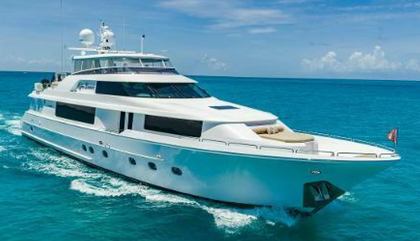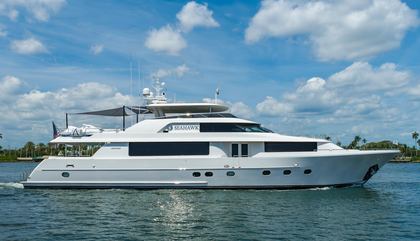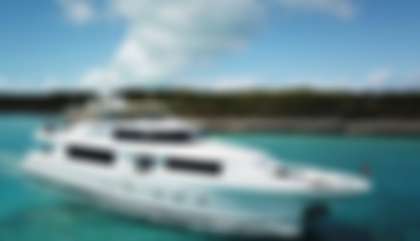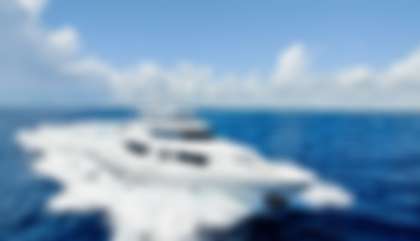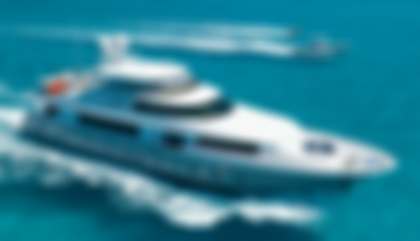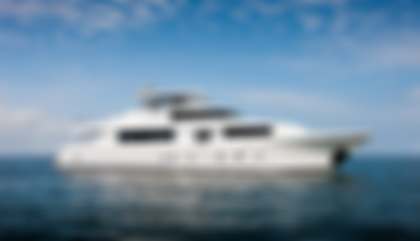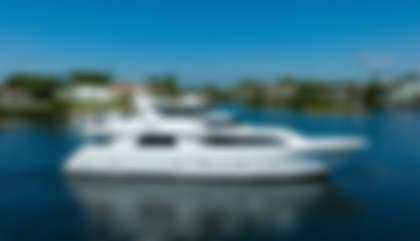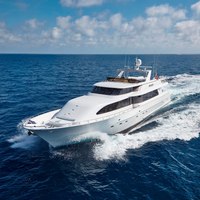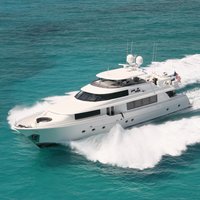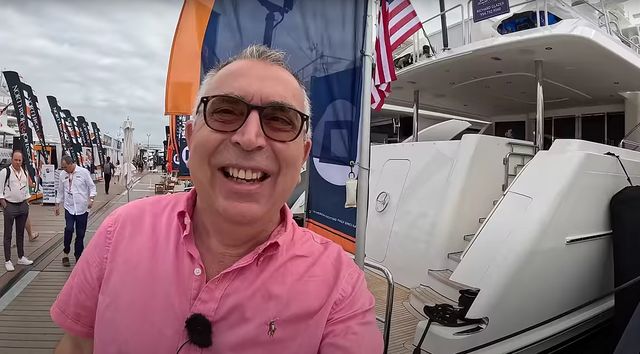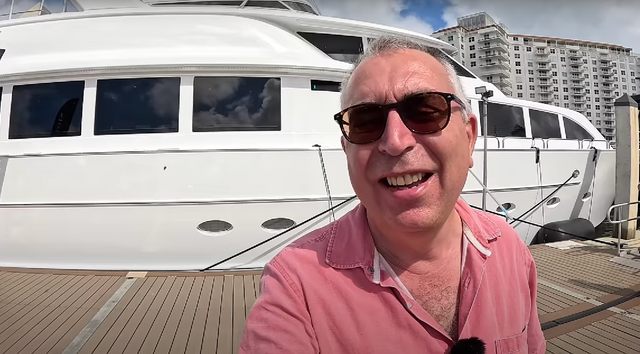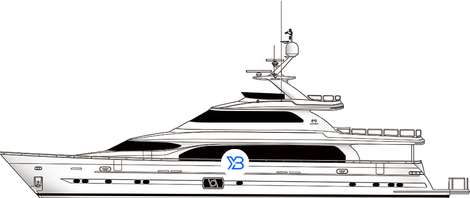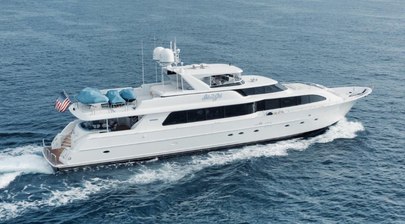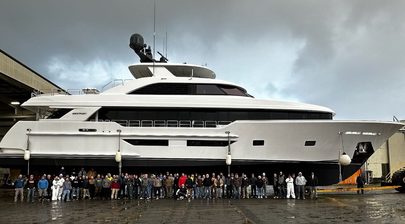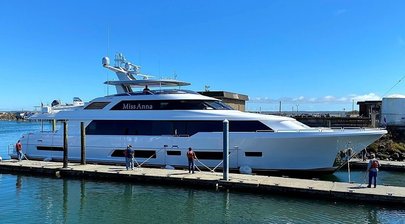-
Mk1YEARS1993 - 2001BUILT11
-
Mk2YEARS2002 - 2018BUILT52
-
Mk3YEARS2017 - 2022BUILT7
Westport 112 Yachts For Sale
The W112 was built in the United States by Westport Yachts making full use of their in-house design team's expertise. The 34m/111'7" superyacht built from GRP can sleep up to eight guests across four cabins. She was available with only one option for inboard engines.
For many yacht owners, the Westport 112 is where serious cruising begins. It’s quick, easy to crew, and just the right size to feel grand without ever feeling unmanageable. Production may have ended, but the W112 still anchors the conversation around 34m yachts. There’s a reason so many are still changing hands.
Westport 112 Buyer's Guide
Buying any yacht takes a mix of head and heart, and the Westport 112 draws on both. This guide is here to help you make sense of the market, the ownership costs, and what to expect once you step aboard. It’s written for anyone considering a 34m (112ft) yacht that blends proven ability with lasting appeal, and for owners who just want a clear, grounded look at what owning one really involves.
- Why Buy a Westport 112?
- Who Buys a Westport 112?
- Three Generations of the W112
- Design & Layout of the Westport 112
- Performance & Engines
- W112 Ownership & Running Costs
- Crewing & Operating a W112
- Insuring & Registering your W112
- Westport 112 Yachts for Sale: Market Price Insight
- Rivals & the Successor to the W112
- Working with a Buyer's Broker
- Buy Smarter with YachtBuyer
Why Buy a Westport 112?
People buy a Westport 112 because it's a yacht built for repeated use and that practicality keeps owners loyal. Big enough for space, small enough to crew - it fits long-term ownership and many owners never outgrow it.
Build and Maintenance
- Composite hull and deck are vacuum-infused and bonded as one shell - no weld seams, no corrosion, and few structural issues even after decades.
- Easy to service in the US; most work handled locally without overseas yards or custom parts.
- Designed for longevity - light, strong, and simple to maintain year after year.
Performance and Range
- Top speed around 25 knots; efficient cruise at 12-14 knots.
- Range of roughly 2,400nm for Florida–Bahamas or New England–Bermuda runs.
- 1.8m (6ft) draft lets it reach shallow anchorages and compact marinas.
Continuity and Value
- Same core design built for nearly 30 years - consistent support, parts, and documentation.
- Known across brokers and captains, which keeps resale strong and valuations steady.
Crew-Friendly Layout
- Full headroom in the engine room, good stores, and safe side decks for easy upkeep.
- Logical systems and layout make long seasons nicer, which is why crews stay.
Why Buy a Used Westport 112?
Compared with building a new 34m yacht, a pre-owned Westport 112 gives immediate access to a proven yacht. There’s no two-year build wait, no trial season chasing snags, and no question about how the W112 will perform. Most have full yard histories and long-term crews who know every system.
Depreciation works in the buyer’s favour. The biggest drop comes in a yacht’s first five years, so a second- or third-generation 112 offers the same speed, volume, and comfort for much less. Many have already had major refits (new paint, systems upgrades, and refreshed interiors) letting the next owner step aboard a turnkey yacht instead of a project.
Westport’s Washington yard still services every W112 ever built, with parts stocked or made in-house. For a model out of production, that level of support is rare and keeps upkeep predictable. The W112 may no longer be new, but it still comes with a live support network.
This mix makes a used Westport 112 one of the most sensible ways into true superyacht ownership. It’s a design that has already proved its worth at sea and in the market.
Who Buys a Westport 112?
The Westport 112 attracts owners who prize more substance from their yachts. Many are seasoned yachtsmen who have spent years with 24-30 m (78-98 ft) boats and are ready to move into full-crew ownership without entering the world of heavy, slow-running superyachts.
Buyers tend to fall into two clear groups:
- Experienced owners trading up: long-time yacht owners moving from smaller models or switching from European builds to something easier to maintain close to home. They appreciate Westport’s steadiness, the quiet comfort of its systems, and the peace of mind that comes with local support.
- First-time superyacht buyers: newcomers to the 30-40m range who already know what running a crewed yacht involves. They choose the 112 because it’s large enough to grow into over many seasons without quickly outgrowing it - a yacht that teaches big-boat ownership while keeping management and costs within reach.
Typical 112 owners tend to be hands-on and confident. They’re less interested in fashion and more in how a yacht feels to live with - how the systems work, how easily the crew can run it, and how well it holds its worth over time. Many are family cruisers who spend weeks on board each year, preferring long passages and quiet anchorages to the spotlight of the marina.
Where the W112 Spends Its Time
- United States and Bahamas: Many W112s work between Fort Lauderdale, the Keys and the Exumas. The draft of 1.7-1.8 m (5.6-5.9 ft) lets them nose into creeks and anchor close to the cays where deeper yachts must stand off. U.S. build and flag simplify running and yard work, and the supply chain across Florida keeps downtime short.
- Caribbean: Winter cruising runs through St. Barths, Antigua, and the Virgin Islands. Local marinas suit 34m (112ft) yachts, and the Westport’s easy draft fits well for anchorages in 5-10m (16-33ft) depths. Some bays now mark turtle and coral zones where anchoring is banned, but captains use tenders to reach the beach with no fuss.
- Mediterranean: Summers see W112s in Spain, Italy, Greece, and Croatia. Ports such as Palma, Portofino, and Athens welcome yachts this size, but berths fill early. France and Spain now enforce seagrass rules that restrict anchoring for vessels over 24m (79ft), so W112s usually drop anchor deeper and run guests ashore by tender.
- Asia-Pacific: A growing group of W112s cruise from Singapore, Phuket, and Hong Kong. The easy systems and long range make them fit for island chains such as Langkawi and Indonesia. Australia sees a few based in Sydney and the Whitsundays, while Japan’s newer superyacht berths now take yachts up to 40m (131ft).
Three Generations of the W112
The Westport 112 stayed in production for nearly thirty years, from 1993 until 2022 which is an unusually long lifespan for a yacht design of this size. Across that time, the model moved through three generations, each keeping the same 34m (112ft) platform but steadily improving how it looked, felt, and performed. Every owner could tailor the interior décor within a set framework, so the changes between generations often mirrored broader design trends.
Westport 112 Mk1 (1993–2001): The First Generation
Launched in 1993, this first generation measured 34.1m (112ft) in length, with a 7.1m (23.3ft) beam and 1.7m (5.6ft) draft. Eleven hulls were built before production moved on to the next series.
This version carried the classic Westport look with a long sheerline, swept superstructure, and styling that has aged remarkably well. Inside, most Westport 112 Mk1 yachts featured high-gloss cherry or mahogany joinery and a traditional four-cabin layout, including a full-beam master stateroom amidships. Power came from early MTU 12V or 16V diesels, giving speeds in the 24-25 knot range, impressive for the mid-1990s.
Every later model built on its foundation and the Mk1 is the purest expression of the original concept – a 34m yacht designed for comfort, reliability, and easy operation in shallow water. Many are still cruising today, often refitted and updated but unmistakably Westport.
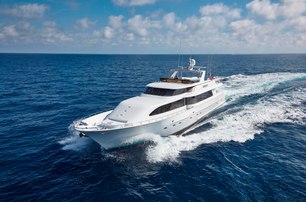
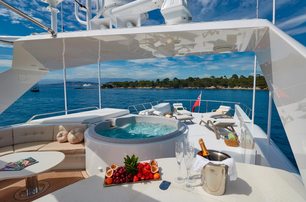
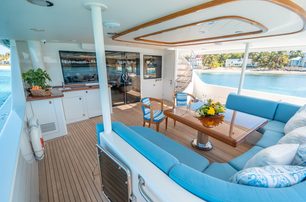
Westport 112 Mk2 (2002–2018)
By the early 2000s, Westport had refined its 34.1m (112ft) formula into something close to perfect. The Westport 112 Mk2 generation arrived in 2002, keeping the same overall dimensions but improving almost everything else. Around 52 yachts were delivered, making this easily the most successful and best-known version.
The hull lines were smoother, the windows fractionally taller, and the superstructure a touch cleaner. Inside, Westport began to move away from dark gloss timber towards lighter satins and softer tones. The four-cabin layout stayed the same - eight guests and up to five crew – but space felt more open, especially in the main salon and country-kitchen galley. From 2012, Westport also offered a five-cabin version with a main deck master in place of the country kitchen.
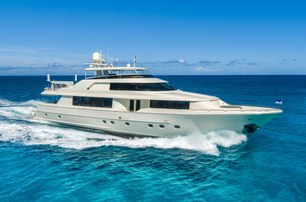

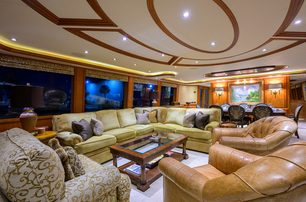
The Mk2 gained newer MTU and Caterpillar engine options, pushing top speed to roughly 25 knots, with a comfortable cruise around 20. Better sound insulation made the ride noticeably quieter too.
Westport shifted to a more advanced composite build and near-production precision, but still offered semi-custom interiors. It gave buyers the best of both worlds: proven engineering with personal choice in finish and layout. For many owners, that balance is why the Mk2 remains the benchmark Westport 112.
Westport 112 Mk3 (2017–2022)
The Westport 112 Mk3 was the final generation. built between 2017 and 2022 and measuring ever so slightly less at 34m (112ft) with the same 7.3m (24ft) beam, but looked noticeably more modern from the dock. Larger hull windows, a lower salon glazing line, and a cleaner arch gave the Mk3 a lighter, more contemporary profile without losing the familiar W112 silhouette. Only seven yachts were completed, giving this series almost limited edition.

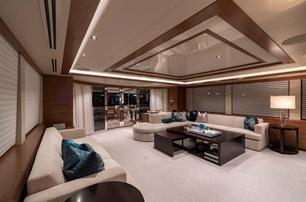
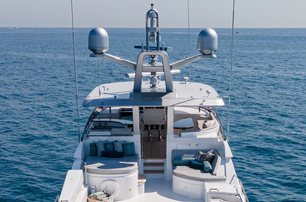
Inside, the atmosphere continued the shift from traditional gloss to modern calm that the Mk2 had started. Westport replaced cherry and mahogany with pale oak and horizontal-grain walnut, used stone and satin finishes in place of lacquer, and added softer lighting throughout. The main staircase was redesigned to open up the deck flow, and the flybridge reworked with a larger bar, modular lounge seating, and improved storage around the tender area.
Technically, the yacht remained true to the Mk2’s formula with twin MTU or Caterpillar engines and around 25 knots at the top end, but onboard comfort improved thanks to upgraded sound insulation, stabilisation, and air-conditioning systems.
Design & Layout of the Westport 112
The Westport 112 was drawn by long-time collaborator Jack Sarin Naval Architects, working alongside Westport’s in-house design and engineering teams. Every yacht was built in Washington State, split between the company’s Hoquiam and Westport shipyards, which together cover more than 170,000 square feet. Those facilities specialised in composite yacht construction from the late 1980s onward, giving Westport the scale and repeatability that made the 112 such a long-lived success.
The hull and superstructure are formed from fiberglass and composite laminates over a foam core, all bonded together with vacuum-infused resin. This single-shell method keeps the structure light yet stiff, free from corrosion, and easier to maintain than metal builds of similar size. Each hull and deck are cured as one continuous moulding, creating strength without relying on heavy framing or fastenings. Bulkheads and stringers are resin-bonded into the structure rather than mechanically fixed, giving the 112 its characteristic solid feel underfoot and its quiet running tone at speed.
The raised-pilothouse layout gives the yacht its familiar profile and separates guest and working areas for smooth operation. On the main deck, a full-beam salon leads to a dining space and the trademark country-kitchen galley, a relaxed, social hub often kept open to guests. The lower deck carries four cabins, including a full-beam owner’s suite amidships, a forward VIP, and two twin guest cabins.
Up top, the flybridge typically holds a bar and grill with free-standing seating and sun pads, though many later Mk3 yachts added a jacuzzi beside the bar. The swim platform sits just above the waterline, wide enough for easy boarding and often used as an informal beach area for diving or launching toys.
Tenders and Toys
On most Westport 112s, the tender sits on the upper deck and is launched by crane, leaving the swim platform clear for swimming and boarding. Some later Mk3 yachts use forward storage or a lighter carbon crane to free more deck space. Most carry a 5-5.5m (16-18ft) tender (like a Williams DieselJet 565 or Nautica RIB) and a pair of jet-skis, with space for smaller toys or dive gear if needed. During a survey, it’s worth noting crane service dates and the condition of lifting points, as these systems see regular use.
Performance & Engines
The Westport 112 draws between 1.7 and 1.8m (5.6-5.9ft), so it slips easily into shallow bays and island harbours where deeper yachts can’t go. At ~208 gross tonnes, it stays light enough for planing speeds but still retain strength. Most Mk2 and all Mk3 yachts carry zero-speed fin stabilisers from Naiad or ABT-TRAC, giving good steadiness both at rest and underway.
Westport 112 Engine Specs
Here’s a quick side-by-side so buyers can see the common Westport 112 engine packages at a glance before diving into survey specifics.
| Specification | MTU 16V2000 (M90/M96) | Caterpillar C32 ACERT |
|---|---|---|
| Configuration | V16 diesel, twin turbocharged | V12 diesel, twin turbocharged |
| Power output (per engine) | 1,790–2,000 hp (1,334–1,491 kW) | 1,900 hp (1,417 kW) |
| Total installed power | 3,580–4,000 hp (2,668–2,983 kW) | 3,800 hp (2,834 kW) |
| Top speed | ≈ 25–26 knots | ≈ 25 knots |
| Cruising speed | ≈ 20–22 knots | ≈ 20–21 knots |
| Range (economical) | ~2,500 nm @ 12 kn | ~2,400 nm @ 12 kn |
| Fuel capacity | 20,800 L (5,500 US gal) | 20,800 L (5,500 US gal) |
| Noise & vibration | Lower with improved Mk2/Mk3 insulation | Slightly higher at high load; easy service access |
| Service network | Global MTU / Rolls-Royce support | Extensive U.S. CAT dealer network |
| Typical fitment | Common on late Mk2 and Mk3 | Common on Mk2, U.S. cruising focus |
Survey Hot Spots
On the brokerage market you’re inheriting the engines already installed. A few yachts were re-powered during major refits, but most retain original MTU or CAT units with overhauls. Prioritise logged hours, overhaul records, and completion of major service intervals - those factors influence future costs far more than the brand badge.
The survey is less about finding faults and more about confirming how the boat has been run. Good surveyors will note the usual items (exhaust lagging, stabiliser seals, chiller hours, teak seams, paintwork, and generator performance) but the story they tell is what counts. A dry bilge, quiet machinery, and up-to-date systems show steady care. These details, along with paperwork to back it up, give the clearest picture of condition and what the first seasons of ownership are likely to cost.
W112 Ownership & Running Costs
Owning a Westport 112 means running a true crewed yacht, yet it remains one of the most predictable models in its class to maintain. The composite hull, sensible systems, and widespread U.S. service support all help control long-term costs.
- Annual budget: Most owners plan between €750,000 and €1.2 million ($800,000-$1.3 million) a year, covering fuel, crew, insurance, dockage, and maintenance.
- Fuel and operations: Typical seasonal fuel use adds up to €200,000-€300,000 ($215,000-$320,000) depending on speed and itinerary. Engine and generator servicing, bottom work, and paint touch-ups usually cost €150,000-€250,000 ($160,000-$270,000) per year.
- Crew costs: A professional crew of five or six (captain, engineer, chef, and stews/deckhands) runs €350,000-€450,000 ($380,000-$490,000) annually, including payroll and rotation cover.
- Insurance and mooring: Premiums average 0.8-1.2% of the insured value, while dockage and winter storage range from €50,000 to €120,000 ($55,000–$130,000) depending on region.
- Refit allowance: A firm piece of advice is that owners reserve 5-10% of the yacht’s value every five years for soft goods, paintwork, and upgrades that protect resale value.
The Westport 112 rewards steady care rather than constant spending. It’s large enough to run as a proper yacht, yet simple enough that maintenance remains manageable. Parts and yard support are still available directly from Westport’s service facility in Washington, which continues to look after even the earliest hulls.
Crewing & Operating a W112
Crewing a W112
A Westport 112 runs best with a dedicated crew of five or six, depending on whether it’s managed for private use or charter. That usually means a captain, chief engineer, chef, chief steward/ess, and two deckhands or stews. The yacht’s systems are designed for professional operation rather than owner-operator use, but daily management is straightforward thanks to Westport’s practical engineering and clear service access.
Crew quarters are located aft, separated from the guest areas by the engine room. The layout typically includes two twin cabins and a captain’s cabin, along with a compact mess and laundry.
For private ownership, most yachts retain a permanent full-time crew who handle all onboard operations, from provisioning to preventive maintenance. Charter-focused yachts often add a rotational engineer or relief captain to cover busy schedules. Retaining a consistent team matters; these yachts benefit from experienced captains who know the systems and maintenance cycles intimately.
All generations of the W112 fall within the MLC and LY3 regulatory thresholds, meaning crewing is simpler and less costly than on larger yachts over 500 GT. Crew contracts, insurance, and compliance are handled much like any other 30-40m (98-131ft) yacht.
Operationally, the W112 is as easy to manage as any yacht in its class. The design gives good sightlines from the pilothouse, sensible mooring layouts, and reliable thrusters for close-quarters handling. Engine rooms are arranged with full standing headroom and labelled service points. Westport’s original build documentation and parts support remain available directly from the shipyard, which simplifies ongoing maintenance and troubleshooting. Many captains continue to work closely with the yard or with experienced Pacific Northwest service teams that know the model inside out.
Legal and Operational Notes
At 34m (112ft) the Westport 112 is large enough for ocean runs but small enough to avoid the layers of red tape that apply to bigger yachts. The rules below are worth knowing but seldom slow things down.
- Pilotage: Many ports ask for a local pilot once a yacht passes 30 m (98 ft). It’s normal in places like Monaco, Dubrovnik, and Sydney, and captains book pilots in advance as part of the passage plan.
- Anchoring rules: France and Spain now protect seagrass beds, so yachts over 24 m (79 ft) must anchor in deeper water or use marked moorings. The 112 handles this easily; crews plan tender runs for short trips ashore.
- Berth size: Most marinas that take yachts over 30 m (98 ft) can house a 112, but space is tight in peak season around the Med and Caribbean. Early booking helps, especially in July and August.
- Emissions and fuel: Older 112s pre-date IMO Tier III limits, but they run within MARPOL standards using low-sulphur fuel. No extra gear is needed for normal worldwide cruising.
- Charter coding: To charter in the Mediterranean, the yacht must meet MCA LY3 or a flag-state equivalent. Many Westport 112s already meet this level; others can upgrade with added fire and safety gear.
Insuring & Registering your W112
Sorting out insurance and registration is a key step when buying a Westport 112. These choices decide how the yacht is used: for private trips, for charter, or a mix of both. Because the 112 is under 500GT, the rules are simpler than for bigger yachts, though it’s still worth getting advice from a broker or maritime lawyer before setting up the ownership and flag.
Every Westport 112 carries two main insurance policies:
- Hull & Machinery, which covers the yacht itself;
- Protection & Indemnity (P&I), which covers damage or injury involving other people or crew;
- Add-ons: Many owners add extra cover for tenders, water toys, or pollution risk, and storm damage.
Designed and built to ABS class standards, with many yachts delivered in class and maintained on the five-year survey cycle, typical premiums are 0.8-1.2% of insured value; harder-risk cases can be higher. For a 112 worth €4-8 million, a possible range could be €32,000-€96,000 ($35,000-$105,000) each year. Insurers will look closely at service logs, surveys, and crew records before quoting a rate. Well-kept yachts with full paperwork will often qualify for better terms.
Most U.S.-based yachts are USCG-documented, while others carry flags from the Cayman Islands or Marshall Islands. These registries are well known, flexible for charter, and accepted by most insurers. They also keep crewing and tax rules clear for yachts under 500GT.
For those planning to cruise in Europe, VAT status is important. A U.S.-flagged yacht can enter EU waters under temporary import for limited periods, or through an EU-based holding company if long-term use is planned.
Ownership is often held through a Special Purpose Vehicle (SPV), a simple company formed to own the yacht. It separates liability, simplifies resale, and helps manage charter income. These SPVs are often registered in Cayman, Delaware, or Malta, depending on where the yacht operates.
Good insurance is built on a clear record. A Westport 112 with current class papers, complete service history, and stable crew will always earn stronger quotes and better renewals. For buyers, those records speak louder than any sales pitch as they show how well the yacht has been cared for and what kind of ownership lies ahead.
Westport 112 Charter Potential
Many Westport 112s operate successfully in charter, particularly in the U.S. and Caribbean. The yacht’s size and layout make it easy to code under MCA LY3 while remaining under the 500GT threshold. Most charter setups use the four-stateroom layout with zero-speed fins and neutral interiors that appeal to guests. Again, keeping safety certificates, fire systems, and surveys up-to-date allows an owner to switch between private use and commercial operation with minimal changes.
Westport 112 Yachts for Sale: Market Price Insight
The Westport 112 has stayed busy on the brokerage scene for nearly thirty years. You can see all current listings in the Used Westport 112 Yachts for Sale section, where each generation is shown with live asking prices and photos.
How the W112 Trades
The Westport 112 keeps a steady rhythm in the resale world. Mk2 yachts change hands most often and tend to move faster than early Mk1s, while Mk3s are fewer and hold their worth thanks to newer gear and shorter build runs. Across all builds, solid logs, clean paint, and up-to-date stabilisers carry more weight than any cosmetic touch-up. Good records and steady care help a yacht sell sooner and closer to its asking price.
The charts that follow draw on verified YachtBuyer MarketWatch records of sold prices. Read them alongside the live market data and the current price gauges for a clear view of how the 112 trades today and how values have held through the years.
Historic Market Overview
Here you can explore the proven sales data in interactive graphs:
- Historic Prices: All Generations: a single graph showing the long-term path of sold prices across the full Westport 112 run, so you can see how values have risen or dipped through changing markets.
- Price Trends by Generation (Mk1-Mk3): three graphs, one for each generation, showing how age, upkeep, and refits shape resale within each group.
Rivals & the Successor to the W112
Few yachts of this size have been built in such numbers in the United States, and that alone gives the Westport 112 a distinct place in the market. But buyers often weigh it against a handful of strong rivals in this bracket.
Below are three good examples that fall within the same ownership window, each reflecting a different style of build and design philosophy. For more detailed performance and specification comparisons, see the section on Westport 112 Rivals and Head-to-Heads.
Lower Price Point - Horizon RP110
The Horizon RP110, built by Horizon Yachts in Taiwan, is a natural comparison for early Westport 112s or yachts midway through their service life. It shares the W112’s composite construction and raised pilothouse layout and runs at similar cruising speeds, with a touch more beam and a slightly more modern exterior. Horizon’s global service reach make it an appealing option for owners who value predictable upkeep and straightforward engineering.
Mid-Range Price Point - Monte Carlo Yachts MCY 105
The MCY 105 is built in Monfalcone, Italy, by Monte Carlo Yachts, part of the Bénéteau Group. It sits squarely in the middle of the Westport ownership range, overlapping late Mk1s and Mk2s. The design brings Italian style and light-filled interiors to the same 32 metre footprint, offering a more open and contemporary take on the raised pilothouse idea. Its carbon-reinforced composite hull keeps weight low and range competitive, while the finish quality and design flair appeal to buyers looking for something elegant yet practical.
Higher Price Point - Ocean Alexander 32L
At the upper end of the spectrum sits the Ocean Alexander 32L, also built in Taiwan, with strong support through the yard’s U.S. network. Slightly longer and heavier than the W112, it trades outright speed for a smoother, quieter ride. The semi-displacement hull delivers a comfortable cruising range, and the interior volume is exceptional for its length. Engineering quality is excellent, with service points designed for long-term crewed operation. It’s often chosen by owners who admire the Westport’s reliability but prefer a more modern silhouette and updated systems.
The Successor: Westport 117
In 2022, Westport replaced the W112 with the Westport 117, carrying the same raised-pilothouse profile into a slightly longer hull. The new model measures 35.8m (117ft) with a broader beam of 7.6m (24.9ft) and updated glazing, offering around 20% more interior volume while keeping the same running speed and shallow draft.
The W117’s styling is sharper, with larger windows, cleaner lines, and an interior that shifts further towards open-plan living. It retains the W112’s familiar layout flow (large salon, country-kitchen galley, four guest cabins, and aft crew quarters) but has more headroom and light.
Working with a Buyer's Broker
On a Westport 112, a broker's role is to verify facts, sense-check the price, and make sure the yacht you choose matches how you plan to use it. The right broker turns data into understanding, drawing on real-world experience and platforms such as YachtBuyerPRO to see what others miss.
The process begins with confirmation - checking hull numbers, engine model, stabiliser type, and any major refit history. A full record from YachtBuyerPRO shows when the yacht was launched, where it was built, sale history, charter records and how long it has been on the market.
Next comes context. Brokers compare listings across generations, weighing engine hours, refit dates, and ownership history against current YachtBuyer Market Watch data. That creates a realistic valuation rather than a headline price.
During negotiations, they coordinate surveys, sea trials, and contract terms, everything from oil analysis and stabiliser tests to escrow timing and post-survey adjustments. A good broker will also estimate near-term spending by reviewing the service log for items such as exhaust lagging, AC chillers, paintwork, and electronics.
After purchase, they help line up crew, insurance, and yard slots, ensuring a smooth transition into ownership. It’s a hands-on role built around proof, process, and precision. For a yacht as established as the Westport 112, that partnership often makes the difference between buying with confidence and buying on instinct.
Buy Smarter with YachtBuyer
Each Westport 112 has its own story - how it was used and cared for. Knowing that detail before you buy saves time, risk and therefore money.
YachtBuyer brings those facts together. Our listings are built on verified data, live market tracking, and the same research that shaped this guide. You can compare generations, see how refits or stabilisers affect value, and view each model’s history in clear, practical terms.
If you’re still exploring, Video Yacht Tours & Walkthroughs offer a first-hand look at design and layout before you step aboard.
Market Price Insight
Current prices show that a 7-year-old W112 is available from €14,099,000. For previous generations, a first generation 32-year-old model is available from €3,286,000 and a second generation 22-year-old model is available from €5,124,000.
New Westport 112 - Built to order

Configure Your Own
Westport W117 Yacht
- Choose color, fabric & specification
- Select your layout
- Warranty & Dealer Support
- Fewer maintenance costs

Used Westport 112 Yachts for sale
View a wide selection of pre-owned Westport 112 Yacht for sale in your area, explore detailed information & find the perfect Westport 112 Yacht for you.
12 Pre-Owned Westport 112 Yachts for sale
Westport Yachts
2014 REMY ROO34m | Westport 112 (Mk2)
2 x MTU 2,100hp
Fort Lauderdale, Florida, United States
Westport Yachts
2014 SEAHAWK34m | Westport 112 (Mk2)
2 x MTU 2,000hp
West Palm Beach, Florida, United States
Westport Yachts
2012 S*****34m | Westport 112 (Mk2)
2 x MTU 2,100hp
Features: Stabilisers, Swim Platform, Aircon, Bow Thruster
Westport Yachts
2011 C*****34m | Westport 112 (Mk2)
2 x MTU 2,000hp
Fort Lauderdale, Florida, United States
Westport Yachts
2011 (Refit: 2022) Y*****34m | Westport 112 (Mk2)
2 x MTU 2,000hp
Features: Swim Platform, Aircon
United States
Westport Yachts
2008 EXODUS34m | Westport 112 (Mk2)
2 x MTU 2,735hp
Fort Lauderdale, Florida, United States
Westport Yachts
2006 (Refit: 2022) N*****34m | Westport 112 (Mk2)
2 x MTU 2,000hp
Features: Stabilisers, Swim Platform, Aircon, Bow Thruster
United States
Westport Yachts
2003 (Refit: 2021) H*****34m | Westport 112 (Mk2)
2 x MTU 1,800hp
Features: Swim Platform, Aircon
Aventura, Florida, USA
Westport Yachts
2002 (Refit: 2016) I*****34m | Westport 112 (Mk1)
2 x MTU 1,850hp
Features: Swim Platform, Aircon, Bow Thruster
Westport Yachts
2001 (Refit: 2017) I*****34m | Westport 112 (Mk1)
2 x MTU 1,800hp
Features: Swim Platform, Aircon
United States
Westport Yachts
2001 M*****29m | Westport 112 (Mk1)
2 x MTU 1,480hp
Features: Stabilisers, Swim Platform
Jupiter, Florida, USA
Westport Yachts
2001 SUPERSTAR34m | Westport 112 (Mk1)
2 x MTU 2,735hp
Fort Lauderdale, Florida, United States
1 Not for sale to US residents while in US waters
2 Approx Price Conversion
Pictures shown are for illustration purposes only. Actual Yacht may vary due to client options.
LIVE: Used Westport 112 Yacht Prices
Find out how much a pre-owned Westport 112 may cost based upon the asking price of all yachts currently for sale globally according to YachtBuyer Market Watch & our sales listings.
Market Price Insight
YachtBuyer’s Market Watch reports that there are currently 12 Westport 112 yachts listed for sale globally, with prices spanning a wide range due to generational differences and features. First generation models (Mk1, 1993 - 2001) are the most affordable, priced between €2.8 million and €3.4 million, with an average asking price of €3.2 million. In contrast, the newest third generation models (Mk3, 2017 - 2022) are likely to be priced much higher, reflecting their advanced technology, more modern design, and newer construction. There are currently none for sale globally. Second generation yachts (Mk2, 2002 - 2018) fall in the middle, priced between €4.3 million and €6.8 million, averaging €5.5 million. The arrival of the latest third generation models has influenced the pricing of earlier generations, as their updated styling, features and cutting-edge appeal shift buyer preferences, resulting in more competitive pricing for older models. This trend highlights how innovation drives market dynamics for the Westport 112 line.
Westport 112 (Mk1) Price
1993 - 2001
- Average Price €3.2m
- Price Range €2.8m - €3.4m
- Average Age 24 years
Recent Sales
-
Model YearLast Asking PriceSold Date
-
2000€4.2mNov-2021
-
2001€2.8mSep-2020
-
1999€2.6mAug-2019
Members Only Register - it's free
Westport 112 (Mk2) Price
2002 - 2018
- Average Price €5.5m
- Price Range €4.3m - €6.8m
- Average Age 15 years
Recent Sales
-
Model YearLast Asking PriceSold Date
-
2012€6.5mNov-2025
-
2011€5.6mAug-2025
-
2010€5.2mJul-2025
Members Only Register - it's free
Westport 112 (Mk3) Price
2017 - 2022
- Average Price -
- Price Range -
- Average Age -
Recent Sales
-
Model YearLast Asking PriceSold Date
-
2017€12.1mDec-2024
-
2021€15.2mApr-2022
-
2021€13.4mMar-2022
Members Only Register - it's free
Average asking price according to YachtBuyer data (12 yachts available). Prices may vary depending on specification, condition and extras.
Historic Price Comparison
The Westport 112, spanning three generations, has shown distinct pricing patterns over the last three years, driven by market factors like demand, condition, and features. The first generation models have the longest average time on the market, sitting for about 748 days, suggesting lower demand for the older features, and on average, they end up 14.45% lower than their initial asking price. The second generation models spend the shortest time on the market, on average around 459 days, suggesting they remain appealing to a specific segment of buyers despite their older features, and on average, they end up 12.25% lower than their initial asking price.
Westport 112 Yacht Price Trends & Sales Graphs (3-Year Data)
Westport 112 (Mk1) Prices
1993 - 2001 Discontinued
Westport 112 (Mk2) Prices
2002 - 2018 Discontinued
Westport 112 (Mk3) Prices
2017 - 2022 Discontinued
Westport 112 Model Overview & Timeline
Westport Yachts started development on the W112 in 1993 and the first model rolled off the production line in 1994. There was a large break of nine years before the second generation was launched in 2002. The third and final generation Westport Yachts W112 was announced in 2015.
-
-
- Westport 112 - Mk1
- 1993 - 2001
- Discontinued
- More
- Length (LOA): 34.14m
- Beam: 7.1m
- Draft: 1.7m
- Speed: 24 Knots
- Full Details & Spec
-
-
-
- Westport 112 - Mk2
- 2002 - 2018
- Discontinued
- More
- Length (LOA): 34.14m
- Beam: 7.24m
- Draft: 1.68m
- Speed: 25 Knots
- Full Details & Spec
-
-
-
- W112 - Mk3
- 2017 - 2022
- Discontinued
- More
- Length (LOA): 34m
- Beam: 7.3m
- Draft: 1.8m
- Speed: 26 Knots
- Full Details & Spec
-
Westport 112 Awards
Video Yacht Tours & Walkthroughs
Rivals & Head-to-Head
Westport 112 Rivals
We've hand-picked a series of similar and direct rival yachts help you identify the strengths of the Westport 112 among its peers. These rivals include the Dutch Moonen Martinique 112 and the American Ocean Alexander 118 Megayacht.
Head to Head
Visually compare everything from performance to layout for these closely matched models from competing builders.
Westport 112 News
Browse our collection of articles and commentary on the Westport 112 from Westport Yachts.
Westport 112 FAQ
A selection of frequently asked questions from buyers
-
There are three generations of the Westport 112. The first generation measures 34.14m. The second generation measures 34.14m. The third generation measures 34m.
-
There are three generations of the Westport 112. The first generation has a top speed of 24 knots. The second generation has a top speed of 25 knots. The third generation has a top speed of 26 knots.
-
The first Westport 112 was launched in 1993 and was in production for 8 years. The second generation was launched in 2002 and was in production for 16 years. The latest generation started production in 2019 and ended production in 2022
-
Current prices show that a 7-year-old W112 is available from €14,099,000. For previous generations, a first generation 32-year-old model is available from €3,286,000 and a second generation 22-year-old model is available from €5,124,000.
-
Depending on your layout choice, the Westport 112 has three generations and the latest generation can support up to eight guests in four cabins.
-
The Westport 112 is a Superyacht
-
To start the process of buying your own Westport Yachts Westport 112, please get in touch with us or contact a buyer’s broker.
We're committed to making yacht buying easier, so if you can't find what you're looking for just ask.


